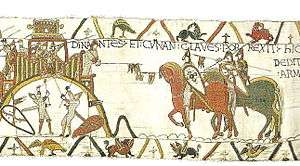Breton–Norman War
The Breton–Norman War of 1064–66 was fought between the Duchy of Brittany and the Duchy of Normandy.
Brittany, an independent Celtic duchy, had a traditional rivalry with neighboring Normandy. The 1064–1065 war between Brittany and Normandy was sparked after William the Conqueror, as Duke of Normandy, supported Rivallon I of Dol's rebellion against the hereditary Duke of Brittany, Conan II.[1]
In 1065, the year before his invasion of Anglo-Saxon England, William of Normandy sent word to the surrounding countries (including Brittany), warning them against attacking his lands, on the grounds that his mission bore the papal banner.[2] However, Conan promptly informed the duke that he would take the opportunity to invade the latter's Duchy. William's army set out for battle. While outside the monastery of Mont Saint-Michel, two Norman soldiers became mired in quicksand, and Harold Godwinson, future King of England saved them.


The Battle of Dinan occurred in 1065. Harold fought on the side of William whose army chased Conan from Dol-de-Bretagne to Rennes and he finally surrendered at Château de Dinan, Brittany. The battle is recalled in the Bayeux Tapestry (see illustration).[3]
During Conan's 1066 campaign against Anjou, he took Pouancé and Segré, and arrived in Château-Gontier. There he was found dead on 11 December after donning poisoned riding gloves. Duke William was widely suspected.[4]
Conan II was succeeded by his sister, Hawise, whose marriage to Hoel of Cornwall may have been a political move to consolidate and stabilize the east and west regions of the duchy.
References
- ↑ "Brittany Genealogy"
- ↑ Howarth 2008.
- ↑ Note: In the Bayeux Tapestry, Conan is pictured surrendering by giving William the keys to Dinan via a lance.
- ↑ Howarth 2008, pp. 98–99.
Bibliography
- Howarth, David Armine (2008) [1977]. 1066: The Year of the Conquest. Paw Prints. ISBN 978-1-4395-1242-5.
